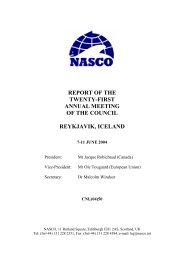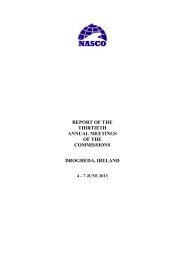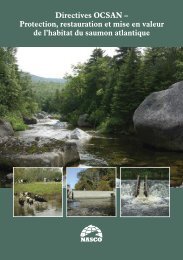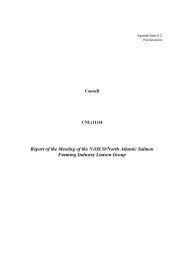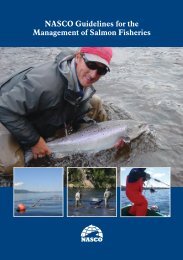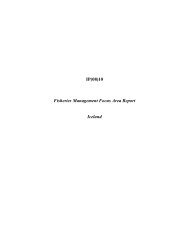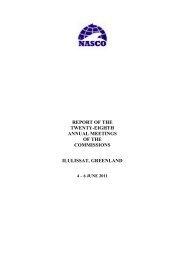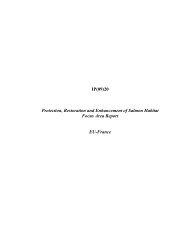Report of the 2005 ICES/NASCO Symposium on Interactions ...
Report of the 2005 ICES/NASCO Symposium on Interactions ...
Report of the 2005 ICES/NASCO Symposium on Interactions ...
You also want an ePaper? Increase the reach of your titles
YUMPU automatically turns print PDFs into web optimized ePapers that Google loves.
NINA SPECIAL REPORT 34<br />
C<strong>on</strong>trol and treatment <str<strong>on</strong>g>of</str<strong>on</strong>g> Gyrodactylus<br />
salaris<br />
Jarle Steinkjer and Edmund Peeler<br />
Gyrodactylus salaris is a freshwater, m<strong>on</strong>ogenean ectoparasite<br />
<str<strong>on</strong>g>of</str<strong>on</strong>g> Atlantic salm<strong>on</strong>. Infecti<strong>on</strong> <str<strong>on</strong>g>of</str<strong>on</strong>g> its original host,<br />
Atlantic salm<strong>on</strong> in <str<strong>on</strong>g>the</str<strong>on</strong>g> Baltic watershed, is generally<br />
inapparent. It is <strong>on</strong>ly <strong>on</strong> Atlantic stocks <str<strong>on</strong>g>of</str<strong>on</strong>g> Atlantic salm<strong>on</strong><br />
(Salmo salar) that <str<strong>on</strong>g>the</str<strong>on</strong>g> parasite multiplies unchecked<br />
causing a high level <str<strong>on</strong>g>of</str<strong>on</strong>g> mortality in juveniles and,<br />
c<strong>on</strong>sequently, dramatic reducti<strong>on</strong>s in wild populati<strong>on</strong>s. In<br />
1975 <str<strong>on</strong>g>the</str<strong>on</strong>g> parasite was introduced into Norway, probably<br />
through <str<strong>on</strong>g>the</str<strong>on</strong>g> importati<strong>on</strong> <str<strong>on</strong>g>of</str<strong>on</strong>g> Atlantic salm<strong>on</strong> smolts from<br />
<str<strong>on</strong>g>the</str<strong>on</strong>g> Baltic regi<strong>on</strong>, and has dramatically reduced stocks <str<strong>on</strong>g>of</str<strong>on</strong>g><br />
Atlantic salm<strong>on</strong> in 45 rivers. It is known to be present in<br />
Denmark and Germany and is likely to have been<br />
introduced into o<str<strong>on</strong>g>the</str<strong>on</strong>g>r European countries with <str<strong>on</strong>g>the</str<strong>on</strong>g><br />
importati<strong>on</strong> <str<strong>on</strong>g>of</str<strong>on</strong>g> live rainbow trout (<strong>on</strong>ly <str<strong>on</strong>g>the</str<strong>on</strong>g> UK and Eire<br />
have dem<strong>on</strong>strated freedom from <str<strong>on</strong>g>the</str<strong>on</strong>g> parasite). G. salaris<br />
can infect rainbow trout (Oncorhynchus mykiss)<br />
permanently, and cause infecti<strong>on</strong> <str<strong>on</strong>g>of</str<strong>on</strong>g> up to 50 days in<br />
several o<str<strong>on</strong>g>the</str<strong>on</strong>g>r species. In this paper <str<strong>on</strong>g>the</str<strong>on</strong>g> acti<strong>on</strong> plan<br />
implemented by <str<strong>on</strong>g>the</str<strong>on</strong>g> Norwegian authorities to combat <str<strong>on</strong>g>the</str<strong>on</strong>g><br />
parasite will be reviewed. The plan includes surveillance<br />
to ensure early detecti<strong>on</strong>, preventi<strong>on</strong> <str<strong>on</strong>g>of</str<strong>on</strong>g> <str<strong>on</strong>g>the</str<strong>on</strong>g> spread <str<strong>on</strong>g>of</str<strong>on</strong>g> <str<strong>on</strong>g>the</str<strong>on</strong>g><br />
parasite to uninfected rivers, and measures to eradicate<br />
<str<strong>on</strong>g>the</str<strong>on</strong>g> parasite through chemical treatment and barriers to<br />
migrati<strong>on</strong>. Chemical treatment has been implemented in<br />
a total <str<strong>on</strong>g>of</str<strong>on</strong>g> 27 out <str<strong>on</strong>g>of</str<strong>on</strong>g> 45 infected watercourses in Norway.<br />
For countries such as <str<strong>on</strong>g>the</str<strong>on</strong>g> UK and Eire that are free <str<strong>on</strong>g>of</str<strong>on</strong>g> <str<strong>on</strong>g>the</str<strong>on</strong>g><br />
parasite, and have significant stocks <str<strong>on</strong>g>of</str<strong>on</strong>g> potentially<br />
susceptible Atlantic salm<strong>on</strong>, preventing <str<strong>on</strong>g>the</str<strong>on</strong>g> introducti<strong>on</strong> <str<strong>on</strong>g>of</str<strong>on</strong>g><br />
<str<strong>on</strong>g>the</str<strong>on</strong>g> parasite is <str<strong>on</strong>g>the</str<strong>on</strong>g> major objective <str<strong>on</strong>g>of</str<strong>on</strong>g> any c<strong>on</strong>trol<br />
programme. However, c<strong>on</strong>tingency plans to minimise <str<strong>on</strong>g>the</str<strong>on</strong>g><br />
impact <str<strong>on</strong>g>of</str<strong>on</strong>g> <str<strong>on</strong>g>the</str<strong>on</strong>g> parasite, if introduced, are also critical.<br />
Restricti<strong>on</strong> <str<strong>on</strong>g>of</str<strong>on</strong>g> live fish movements is central to <str<strong>on</strong>g>the</str<strong>on</strong>g> c<strong>on</strong>trol<br />
<str<strong>on</strong>g>of</str<strong>on</strong>g> <str<strong>on</strong>g>the</str<strong>on</strong>g> spread <str<strong>on</strong>g>of</str<strong>on</strong>g> G. salaris between catchments. The<br />
potential importance <str<strong>on</strong>g>of</str<strong>on</strong>g> o<str<strong>on</strong>g>the</str<strong>on</strong>g>r routes (e.g. fishing gear) will<br />
be c<strong>on</strong>sidered in <str<strong>on</strong>g>the</str<strong>on</strong>g> light <str<strong>on</strong>g>of</str<strong>on</strong>g> <str<strong>on</strong>g>the</str<strong>on</strong>g> survival characteristics <str<strong>on</strong>g>of</str<strong>on</strong>g><br />
<str<strong>on</strong>g>the</str<strong>on</strong>g> parasite <str<strong>on</strong>g>of</str<strong>on</strong>g>f <str<strong>on</strong>g>the</str<strong>on</strong>g> host. Differences in <str<strong>on</strong>g>the</str<strong>on</strong>g> c<strong>on</strong>trol <str<strong>on</strong>g>of</str<strong>on</strong>g> G.<br />
salaris in Norway and <str<strong>on</strong>g>the</str<strong>on</strong>g> UK will be discussed.<br />
Poster Presentati<strong>on</strong>s<br />
S<strong>on</strong>ic tracking <str<strong>on</strong>g>of</str<strong>on</strong>g> wild cod, Gadus morhua, in<br />
an inshore regi<strong>on</strong> where cod aquaculture is<br />
developing<br />
Paul Brooking, Gino Doucette and Fred Whoriskey<br />
East Coast North American finfish farmers are beginning<br />
to diversify into <str<strong>on</strong>g>the</str<strong>on</strong>g> culture <str<strong>on</strong>g>of</str<strong>on</strong>g> fishes o<str<strong>on</strong>g>the</str<strong>on</strong>g>r than Atlantic<br />
salm<strong>on</strong>. Sea cage trials have begun with Atlantic cod<br />
(Gadus morhua). We fitted inshore wild cod with s<strong>on</strong>ic<br />
tags during <str<strong>on</strong>g>the</str<strong>on</strong>g> summer <str<strong>on</strong>g>of</str<strong>on</strong>g> 2004, to provide data <strong>on</strong> <str<strong>on</strong>g>the</str<strong>on</strong>g><br />
habitats <str<strong>on</strong>g>the</str<strong>on</strong>g>y used, <str<strong>on</strong>g>the</str<strong>on</strong>g>ir temporal residency, and <str<strong>on</strong>g>the</str<strong>on</strong>g>ir<br />
coastal movements. This informati<strong>on</strong> can help determine<br />
<str<strong>on</strong>g>the</str<strong>on</strong>g> potential for interacti<strong>on</strong> am<strong>on</strong>g wild and escaped<br />
farmed cod, and escaped cod and o<str<strong>on</strong>g>the</str<strong>on</strong>g>r species. Wild<br />
cod remained within a restricted corridor in <str<strong>on</strong>g>the</str<strong>on</strong>g> inshore<br />
z<strong>on</strong>e. They generally c<strong>on</strong>centrated in deep holes (~ 100<br />
m) but undertook local movements, possibly related to<br />
feeding. There was a gradual movement <str<strong>on</strong>g>of</str<strong>on</strong>g>fshore<br />
detected as winter advanced, with fish <str<strong>on</strong>g>of</str<strong>on</strong>g> reproductive size<br />
moving away first, possibly to <str<strong>on</strong>g>of</str<strong>on</strong>g>fshore spawning areas.<br />
One fish was still present in February <str<strong>on</strong>g>2005</str<strong>on</strong>g>. Cod, known<br />
Atlantic salm<strong>on</strong> smolt predators, resided in <str<strong>on</strong>g>the</str<strong>on</strong>g> principal<br />
migrati<strong>on</strong> corridor for smolts from severely depressed<br />
wild Atlantic salm<strong>on</strong> populati<strong>on</strong>s. If escapes <str<strong>on</strong>g>of</str<strong>on</strong>g> farmed<br />
cod occur, and <str<strong>on</strong>g>the</str<strong>on</strong>g>y occupy <str<strong>on</strong>g>the</str<strong>on</strong>g> same habitats as <str<strong>on</strong>g>the</str<strong>on</strong>g>ir wild<br />
counterparts, it could increase predati<strong>on</strong> up<strong>on</strong> salm<strong>on</strong><br />
smolts. Siting and engineering <str<strong>on</strong>g>of</str<strong>on</strong>g> cod farms should be<br />
d<strong>on</strong>e to minimize <str<strong>on</strong>g>the</str<strong>on</strong>g> probability <str<strong>on</strong>g>of</str<strong>on</strong>g> escapes.<br />
Genetic variati<strong>on</strong> after and before <str<strong>on</strong>g>the</str<strong>on</strong>g><br />
Atlantic salm<strong>on</strong> supportive breeding<br />
programme in <str<strong>on</strong>g>the</str<strong>on</strong>g> rivers Ulla and Lérez<br />
(Galicia, Spain)<br />
Maria Saura, Pablo Caballero, Armando Caballero and Paloma<br />
Morán<br />
Management <str<strong>on</strong>g>of</str<strong>on</strong>g> wild Atlantic salm<strong>on</strong> (Salmo salar L.)<br />
populati<strong>on</strong>s based <strong>on</strong> stocking procedures has been<br />
widespread over <str<strong>on</strong>g>the</str<strong>on</strong>g> European range <str<strong>on</strong>g>of</str<strong>on</strong>g> this species<br />
during <str<strong>on</strong>g>the</str<strong>on</strong>g> sec<strong>on</strong>d half <str<strong>on</strong>g>of</str<strong>on</strong>g> <str<strong>on</strong>g>the</str<strong>on</strong>g> past century. In sou<str<strong>on</strong>g>the</str<strong>on</strong>g>rn<br />
European rivers, stock transfers from nor<str<strong>on</strong>g>the</str<strong>on</strong>g>rn European<br />
countries have been justified by a severe decline in native<br />
populati<strong>on</strong>s. However, <str<strong>on</strong>g>the</str<strong>on</strong>g> efficiency <str<strong>on</strong>g>of</str<strong>on</strong>g> this type <str<strong>on</strong>g>of</str<strong>on</strong>g><br />
management to increase effective populati<strong>on</strong> size has<br />
been very poor, mainly because <str<strong>on</strong>g>the</str<strong>on</strong>g> stocks employed for<br />
supplementati<strong>on</strong> presented genetic characteristics<br />
different from those <str<strong>on</strong>g>of</str<strong>on</strong>g> native populati<strong>on</strong>s. Since 1995, all<br />
salm<strong>on</strong> released in <str<strong>on</strong>g>the</str<strong>on</strong>g> rivers Ulla and Lérez (north-west<br />
Spain) are descendants <str<strong>on</strong>g>of</str<strong>on</strong>g> naturally returning adults and <str<strong>on</strong>g>of</str<strong>on</strong>g><br />
wild parr reared until <str<strong>on</strong>g>the</str<strong>on</strong>g> spawner stage wholly in fresh<br />
water (holobiotic rearing), artificially mated in Carballedo<br />
hatchery. The success <str<strong>on</strong>g>of</str<strong>on</strong>g> this supportive breeding<br />
programme has been m<strong>on</strong>itored using physical markers,<br />
and <str<strong>on</strong>g>the</str<strong>on</strong>g> results seem to be satisfactory. To investigate <str<strong>on</strong>g>the</str<strong>on</strong>g><br />
genetic variability ten years after <str<strong>on</strong>g>the</str<strong>on</strong>g> beginning <str<strong>on</strong>g>of</str<strong>on</strong>g> <str<strong>on</strong>g>the</str<strong>on</strong>g><br />
programme and to test <str<strong>on</strong>g>the</str<strong>on</strong>g> genetic differences between<br />
<str<strong>on</strong>g>the</str<strong>on</strong>g> present-day populati<strong>on</strong>s and those before <str<strong>on</strong>g>the</str<strong>on</strong>g><br />
39



